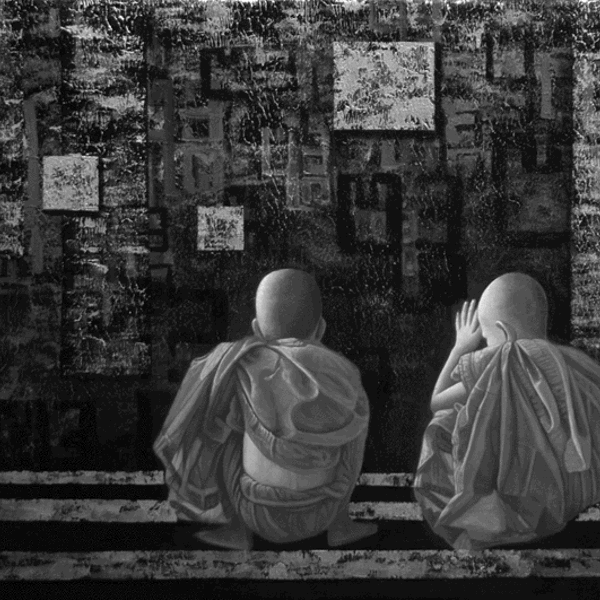An impossibly beautiful country, Myanmar is full of dilapidated colonial structures slowly crumbling in the damp swelter of the tropics, the surface of each slowly losing ground to organic pastels of mosses and molds. Between the housing blocks of downtown Yangon, the country’s largest city and former capital, bundles of fraying wires connect the isolated citizenry with one another. Satellite dishes, cell phones, and Internet cafes connect them with the outside world. On a recent visit to the apartment of a former Yangon city policeman and his family, two color televisions sat playing side-by-side, each with satellite connections, while a wall-mounted air-conditioner hummed quietly nearby. The only electronic gadget not turned on was a multi-speaker stereo system.
“It was bad before,” the eldest of the policeman’s three daughters said over the din in the room. “Then some people died and now it’s still bad.” Her story is emblematic—due to the influence of the Internet and satellite TV—of how much more than ever before the Myanmar people are aware of their own country’s glacial pace of progress than at any point in the past. She happened to be on the street one day during last year’s uprising shouting antigovernment slogans. The next day she stayed in, fearing a stray bullet as she watched the blood-soaked crackdown live on Al Jazeera. “Do you think the Burmese are cowards?” she asked.
It was last year’s social upheaval, sparked by a rise in fuel prices, that inspired hope that a chapter would be closing on the world’s longest-running military regime. But the Buddhist clergy and common citizens were quickly beaten back with batons and bullets, and the world moved on.
During this September’s anniversary a bomb explosion in downtown Yangon wounded four, websites run by dissenters and exiles were attacked and shut down, and about 100 monks filed silently through the streets of a western fishing town to commemorate the crackdown. But this seems hardly dramatic enough to undo the disillusionment that set in after the defeat of the Saffron Revolution. In some ways, it only underscores it.
LURCHING FORWARD, LOST IN TIME
Two years ago—11 months before the monks’ rebellion—I sat in one of the few, cramped Internet cafes in Yangon, the former capital, and glanced at my neighbors’ screens—all soft-core porn and foreign news websites. When I returned this summer, I found the cafes had become diverse and diffuse, packed with young people gabbing away on Google Talk, checking out the social networking sites Orkut, Hi5, and Friendster. Signs posted openly, even in small towns, explained how to circumvent government censors through proxy servers hosted at www.yoyahoo.com and www.bypassany.com.
Myanmar is like that. Change perspectives, and its lost-in-time quality suddenly shifts as well, with a lurch forward. Against the backdrop of the 2,500-year-old golden Swedegon Pagoda, teenagers post photos on Facebook while Korean soap operas compete with English Premier League soccer for people’s attention. Cellphone stores proliferate, despite the cost of new connections—$1,500—from the single, government-owned provider, Myanma Post and Telecommunications. (Black market connections start at about $2,500.)
At night in downtown Yangon, men can be found sitting huddled on low stools beneath the crowded umbrellas of downtown teashops, strumming loud acoustic traditional folk melodies. Despite the demonstrations of 2007, not one is a song of dissention or outrage. The only things exploding these days are the papayas, pineapples, and mangoes—the spirit of protest is, for the most part, silenced.
In fact, the State Peace and Development Council, as the military government renamed itself in 1997, is even more entrenched now than it was a year ago, having profited from global increases in food and fuel prices—Myanmar is an exporter of each. A few signs of conspicuous consumption by the small urban middle class—satellite TV dishes, hip-hop music, and the latest urban fashions—are seeping down from the much smaller class of multimillionaire businessmen directly tied to the junta’s chairman, Than Shwe.
Meanwhile, Myanmar’s broad mass of 50 million people remains among the poorest in the world. Ranked 132nd out of 177 countries in the 2007 United Nation’s Development Program’s Human Development Index, most experts doubt the government’s statistics and think the reality is worse. “It’s so extraordinarily opaque,” offered Sean Turnall, who heads Burma Economic Watch and is a professor of economics at Macquarie University in Sydney. “You’ve got secrecy at every level.”












